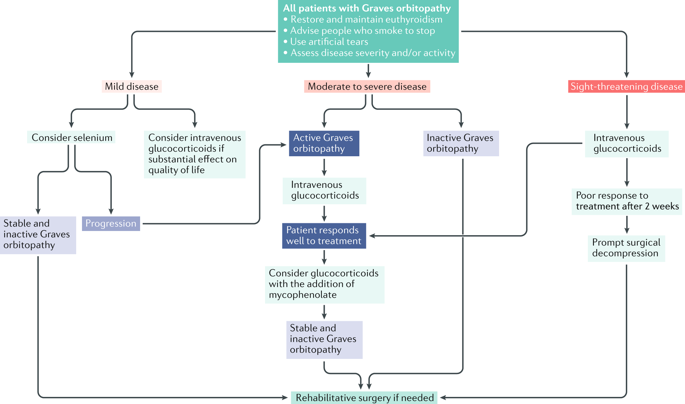当前位置:
X-MOL 学术
›
Nat. Rev. Endocrinol.
›
论文详情
Our official English website, www.x-mol.net, welcomes your
feedback! (Note: you will need to create a separate account there.)
New insights into the pathogenesis and nonsurgical management of Graves orbitopathy.
Nature Reviews Endocrinology ( IF 31.0 ) Pub Date : 2019-12-30 , DOI: 10.1038/s41574-019-0305-4 Peter N Taylor 1 , Lei Zhang 1 , Richard W J Lee 2, 3 , Ilaria Muller 1, 4 , Daniel G Ezra 2 , Colin M Dayan 1 , George J Kahaly 5 , Marian Ludgate 1
Nature Reviews Endocrinology ( IF 31.0 ) Pub Date : 2019-12-30 , DOI: 10.1038/s41574-019-0305-4 Peter N Taylor 1 , Lei Zhang 1 , Richard W J Lee 2, 3 , Ilaria Muller 1, 4 , Daniel G Ezra 2 , Colin M Dayan 1 , George J Kahaly 5 , Marian Ludgate 1
Affiliation

|
Graves orbitopathy, also known as thyroid eye disease or thyroid-associated orbitopathy, is visually disabling, cosmetically disfiguring and has a substantial negative impact on a patient's quality of life. There is increasing awareness of the need for early diagnosis and rapid specialist input from endocrinologists and ophthalmologists. Glucocorticoids are the mainstay of treatment; however, recurrence occurs frequently once these are withdrawn. Furthermore, in >60% of cases, normal orbital anatomy is not restored, and skilled rehabilitative surgery is required. Clinical trials have shown that considerable benefit can be derived from the addition of antiproliferative agents (such as mycophenolate or azathioprine) in preventing deterioration after steroid cessation. In addition, targeted biologic therapies have shown promise, including teprotumumab, which reduces proptosis, rituximab (anti-CD20), which reduces inflammation, and tocilizumab, which potentially benefits both of these parameters. Other strategies such as orbital radiotherapy have had their widespread role in combination therapy called into question. The pathophysiology of Graves orbitopathy has also been revised with identification of new potential therapeutic targets. In this Review we provide an up-to-date overview of the field, outline the optimal management of Graves orbitopathy and summarize the research developments in this area to highlight future research questions and direct future clinical trials.
中文翻译:

Graves 眼眶病的发病机制和非手术治疗的新见解。
Graves 眼眶病,也称为甲状腺眼病或甲状腺相关眼眶病,会导致视觉障碍、美容毁容,并对患者的生活质量产生重大负面影响。人们越来越意识到内分泌学家和眼科医生需要早期诊断和快速专家意见。糖皮质激素是治疗的主要手段;然而,一旦这些被撤回,复发经常发生。此外,在>60%的病例中,正常的眼眶解剖结构没有恢复,需要熟练的康复手术。临床试验表明,添加抗增殖剂(如霉酚酸酯或硫唑嘌呤)可在防止类固醇停止后恶化方面获得相当大的益处。此外,靶向生物疗法已显示出希望,包括减少眼球突出的teprotumumab、减少炎症的利妥昔单抗(抗CD20)和可能对这两个参数都有好处的托珠单抗。其他策略,如轨道放射治疗,在联合治疗中的广泛作用受到质疑。Graves 眼眶病的病理生理学也进行了修订,确定了新的潜在治疗靶点。在这篇评论中,我们提供了该领域的最新概述,概述了 Graves 眼眶病的最佳管理,并总结了该领域的研究进展,以突出未来的研究问题和指导未来的临床试验。其他策略,如轨道放射治疗,在联合治疗中的广泛作用受到质疑。Graves 眼眶病的病理生理学也进行了修订,确定了新的潜在治疗靶点。在这篇评论中,我们提供了该领域的最新概述,概述了 Graves 眼眶病的最佳管理,并总结了该领域的研究进展,以突出未来的研究问题和指导未来的临床试验。其他策略,如轨道放射治疗,在联合治疗中的广泛作用受到质疑。Graves 眼眶病的病理生理学也进行了修订,确定了新的潜在治疗靶点。在这篇评论中,我们提供了该领域的最新概述,概述了 Graves 眼眶病的最佳管理,并总结了该领域的研究进展,以突出未来的研究问题和指导未来的临床试验。
更新日期:2019-12-30
中文翻译:

Graves 眼眶病的发病机制和非手术治疗的新见解。
Graves 眼眶病,也称为甲状腺眼病或甲状腺相关眼眶病,会导致视觉障碍、美容毁容,并对患者的生活质量产生重大负面影响。人们越来越意识到内分泌学家和眼科医生需要早期诊断和快速专家意见。糖皮质激素是治疗的主要手段;然而,一旦这些被撤回,复发经常发生。此外,在>60%的病例中,正常的眼眶解剖结构没有恢复,需要熟练的康复手术。临床试验表明,添加抗增殖剂(如霉酚酸酯或硫唑嘌呤)可在防止类固醇停止后恶化方面获得相当大的益处。此外,靶向生物疗法已显示出希望,包括减少眼球突出的teprotumumab、减少炎症的利妥昔单抗(抗CD20)和可能对这两个参数都有好处的托珠单抗。其他策略,如轨道放射治疗,在联合治疗中的广泛作用受到质疑。Graves 眼眶病的病理生理学也进行了修订,确定了新的潜在治疗靶点。在这篇评论中,我们提供了该领域的最新概述,概述了 Graves 眼眶病的最佳管理,并总结了该领域的研究进展,以突出未来的研究问题和指导未来的临床试验。其他策略,如轨道放射治疗,在联合治疗中的广泛作用受到质疑。Graves 眼眶病的病理生理学也进行了修订,确定了新的潜在治疗靶点。在这篇评论中,我们提供了该领域的最新概述,概述了 Graves 眼眶病的最佳管理,并总结了该领域的研究进展,以突出未来的研究问题和指导未来的临床试验。其他策略,如轨道放射治疗,在联合治疗中的广泛作用受到质疑。Graves 眼眶病的病理生理学也进行了修订,确定了新的潜在治疗靶点。在这篇评论中,我们提供了该领域的最新概述,概述了 Graves 眼眶病的最佳管理,并总结了该领域的研究进展,以突出未来的研究问题和指导未来的临床试验。











































 京公网安备 11010802027423号
京公网安备 11010802027423号